Feeder insects, bugs, and worms are a vital part of your bearded dragon’s diet as they are a source of protein, fats, and other crucial nutrients that these reptiles need for growth and development, maintenance as well as optimum health.
There are both staple and occasional feeder bugs, and you can feed them both live preys and dried ones, with each having their advantages and disadvantages.
Finally, most of these feeder bugs are available for sale, or you can raise them on your own where possible.
Feeding live insects to your beardies
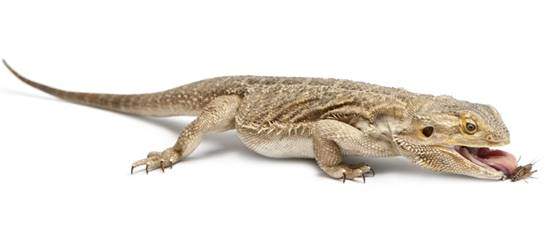
How many insects to feed your bearded dragon will depend on their age and size as well as the size of your feeder insects. Some general feeding tips include:
- Gut-load them 24-48 hours before feeding them to your beardies with their right diets to ensure they are very nutritious. Avoid gut loading using veggies that are high in oxalic acid like spinach or rhubarb or poisonous ones like tomato leaves.
- Pick the correct size of the live feeder bug. They should not be more significant than the space between your bearded dragon’s eye.
- Source them carefully as some carry parasites such as worms. They should be farm-raised and from reputed vendors who ethically raise these insects.
- Beardies can eat staple feeder insects or bugs daily, and they include crickets phoenix worms, roaches, silkworms, crickets, hornworms, locusts, and grasshoppers. Those not a staple should be for occasionally feeding or as a treat depending on which specific bug it is.
- Dust these bugs with calcium, vitamin D3, multivitamins, and other supplements except for the silkworms, which do not require dusting with calcium as they are high in this mineral.
- Ensure you know how to feed your bearded dragons and keep the correct proportion of live feeder insects to those of veggies and greens, fruits (as a treat), and safe plant or flowers. The ratio of feeder insects to plant material should be for adults 20:80, for juveniles 40:60, and baby beardies 80:20.
1. Crickets
Crickets are one of the staple feeder insects for a beardie. There are several species you can raise or buy online that include the banded crickets, house crickets, and silent brown crickets.
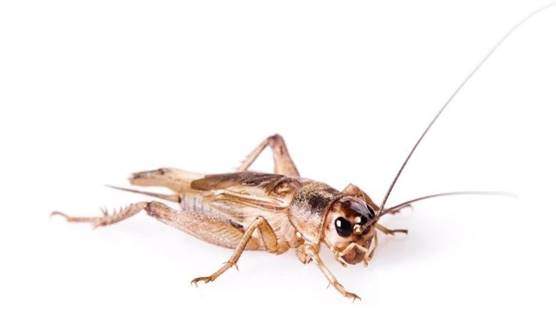
Reasons, why you need to include them as your staple or regular feeder insects for your bearded dragons, include:
- They are nutritious with moisture: 62.9%, proteins: 20.5%, fats: 6.8% and fiber 2.2%.
- They gut-load effectively
- You can get various sizes from pinheads to small to medium to large crickets depending on the size of your bearded dragon.
- They are affordable to buy
- They have a soft exoskeleton making them very easy to eat.
- They will make your beardies get into a hunting activity since they leap.
On how many you should feed your beardies, it depends on their size and the other feeder insects these pets are eating. For instance, a baby bearded can eat 50-80 pinheads in a day, a juvenile can eat 20-40 medium size crickets in a day while an adult can have 10-20 crickets every other day. However, the best way is to let them eat as many as they want for 10-15 minutes.
Besides raising or buying live crickets, you have a choice of going for the dried crickets, including those freeze-dried as they have a longer shelf-life, are cheaper, and you won’t have to hassle with live foods.
Instead of having to buy crickets for bearded dragons each time, you can raise your crickets for use or profits. If you don’t want to keep them, buy a keeper such as Lee’s Kricket Keeper, and food can keep them alive as you feed them to your pet.
If you choose to keep them, do not forget that they stink, make a chirping noise, and will always want to leap to escape. Also, these insects may drown in your bearded dragon’s water bowl. Pick them in case they drown and pick any unfed ones as they may bite your pet at night.
2. Black soldier fly larvae (BSFL) – Phoenix worms or Calci-worms
These are larvae of the Hermetia illucens, popularly known as black soldier fly which some people market as Calci-worms, Phoenix Worms, Reptiworms, Soldier Grubs, NutriGrubs or Beardie Grubs (Australia), and Proticycle (Africa).
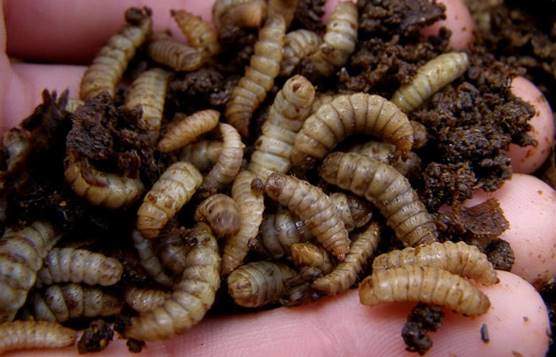
The black soldier flies undergo a complete life cycle of egg, larvae, pupa, and adult stages. However, it is in the larval stage that they are nutritionally peak.
These worms are a staple food juvenile and adult bearded dragons as well as other pets and farm animals, including pigs, poultry, pigs, lizards, turtles, dogs, geckos, and chameleons. Depending on their size, your beardie can eat 10to 30Calci-worms each day.
Some of the reasons why you need to start giving your bearded dragons these black soldier fly larvae include:
- They are high in calcium when compared to other feeder insects (about 8,155ppm while crickets and mealworms have 20-135ppm. They, therefore, can stop, reverse, or prevent metabolic bone diseases (MBD).
- They have a calcium to phosphorus ratio of 1.5:1, which is close to the ideal one that is 2:1. Therefore, don’t dust them. Very high Ca:P ratio will affect phosphorus absorption causing MBD since phosphorus helps in the formation of healthy bones. There is also no need to dust any food if you feed them to your pets regularly with calcium, but you can with vitamin D3 and other supplements.
- They are nutritious with 17.9% protein and 9.4% fats
- The black soldier flies larvae are easy to raise, easy to maintain as they don’t have to eat, are not noisy, don’t bite, and don’t have any odor.
- If fed to gravid female beardies, their clutch size will increase, and their hatchlings will be much healthier.
- Their typical sizes are 3/8” to 3/4” grouped into small, medium, and large BSFL. This small size and their soft body ensure no impaction occurs even in smaller beardies.
- They have lauric acid that will help in killing intestinal parasites (like lipid-coated viruses, protozoa like coccidia, colostrum, among others) that your pet may have.
While they don’t have to eat to be alive, if they are still white, you can feed them carrots, tropical fish flakes, rolled oats, fruits, vegetables, grains, and other organic matter. However, when they turn black-brown, they are about to pupate but can still be fed to your beardie.
Besides raising your own, you can buy live black soldier larvae or dried ones online at very competitive rates.
Finally, while they can be kept at room temperature, putting them at 50-55 degrees F will prolong their lifespan.
3. Roaches like Dubia and discord
Cockroaches are hardy insects that belong to the order Blattodea with over 4600 different species. While some western cultures eat them, they mostly serve as feeder insects for pets, poultry, and other smaller animals that feed on insects. However, home or wild-caught carry bacteria and parasites. Avoid them.
Bearded dragons can eat cockroaches as staple feeder insects (both the adult roach or their nymph). Also, other reptiles, amphibians, birds, small mammals eat them, including frogs, lizards, turtles, rats, mice, and so on.
Common feeder roaches
There are many species of cockroaches bred as feeder insects that vary in size. Common types include the following:
- Dubia Roaches (Blaptica Dubia), also known as Guyana spotted tropical spotted roaches, orange-spotted or Argentinian wood roach.
- Turkestan cockroach (Blatta lateralis) rusty red, red runner cockroach or lat
- Discoid cockroach (Blaberus discoidalis), also known as Haitian, tropical, West Indian Leaf, False Death’s Head cockroach, or drummer.
- Lobster roaches (Nauphoeta cinerea), also known as speckled cockroach
- Orange head cockroach (Eublaberus posticus)
Usually, some people keep the death’s head cockroach (Blaberus craniifer), the Madagascar hissing cockroach (Gromphadorhina portentosa) hisser or hissing cockroaches and Indian Domino Cockroach (Therea petiveriana) as pets.
Key facts
- They are high in proteins with good meat to shell ratio, higher in calcium, ash, and fats when compared to crickets. Furthermore, heavy-bodied hence your pets will eat less.
- Raising and breeding roaches is easy, i.e., they are easy to keep, maintain, and feed. For instance, you feed your Dubia roaches eat oats, whole bread grain, bearded dragon leftover salads, cereal grains, banana, carrot, sweet, potatoes, broccoli stalk, apples, and so on.
- They are odorless, don’t bite, leap, are noninvasive and not noisy.
- They have a long lifespan.
How much cockroaches to give your beardie depends on the size of your roaches as well as the age of this pet. For instance, baby bearded dragons can have 10-20 cockroaches like Dubia 2-3 times a day, juvenile 10-15 cockroaches 1-2 times a day while for adults give them 10-20 roaches, 1-3 times a week.
When feeding roaches to your bearded dragon, you need to get a bowl they cannot climb up. Otherwise, being crawly, they will hide in places your beardies will not find them. If you are one of the people who fear to handle them, go for dried crickets, dried mealworms, and other dead feeder insects.
Finally, you can buy live roaches, including popular species like Dubia, red runner, and Discoid online or in your nearby store.
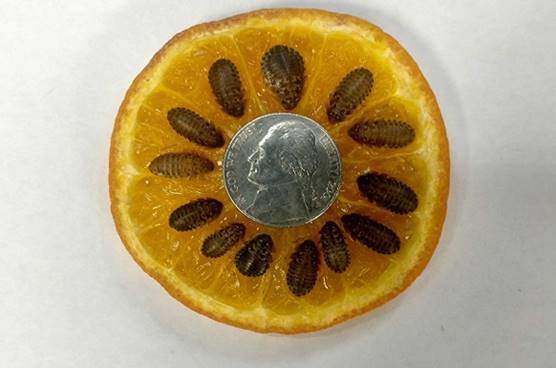
4. Silkworms
These are larvae( grub or caterpillar) of domestic silkmoth (Bombyx mori). They are one of the right choices if you want regular feeder insects.
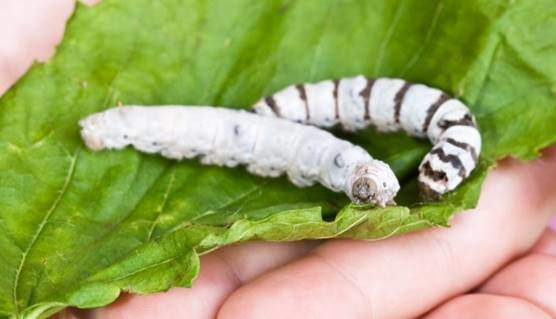
Why silkworm for bearded dragons?
When compared to mealworms, crickets, and waxworms, silkworms have a higher amount of calcium and protein and a lower amount of fats. Furthermore, they are good source magnesium, iron, vitamin B1 B2, B3, sodium, among other nutrients, as well as moisture to keep your beardie hydrated.
Secondly, they are tasty and have a soft body and hence present no chance of impaction even in juvenile or younger pets. If you have egg carrying beardies, this worm will be very beneficial since it has a substantial amount of calcium.
Finally, they also have serrapeptase enzymes that work as a natural pain reliever, cleans teeth, and has anti-inflammatory properties.
Since they come in different sizes, you should order the right size for your pets. The in-between molting stage is known as an instar. Since they molt four times, they have five instars. Their typical sizes are:
- Hatchlings about: 1/8″
- Small (second instar): 3/8″ – 3/4″
- Medium (third instar): 3/4″ – 1.1/4″
- Large (fourth instar): 1/4″ – 1.7/8
- Extra-large (fifth instar) 1.7/8″ – 3″
IF you want to buy them, live silkworms sold in cups that are preloaded with their food to ensure they remain healthy and nutritious. However, raise your silkworms even for profit as they attract a good price.
If you are raising them, you deserve to know that feed on primarily mulberry leaves but also eat Sage orange. With a ventilated plastic container or a tray and mulberry leaves or commercial foods like the Coastal Silkworms Chow, you are good to go.
Finally, if you are raising or handling them, sanitize your hands before touching them or their foods to avoid giving them bacterial infections.
5. Hornworms
Hornworms are larvae of the Manduca sexta moth popularly known as tobacco hawk moth, tobacco hornworm, Caroline sphinx moth, or goliath worm.
They feed mainly on plant foliage with a preference to solanaceous plants such as tomatoes, Datura, petunia, deadly nightshade, eggplant, and tobacco, and when attacked by their predators, they bite and trash their predators.
Can bearded dragons eat hornworms? Yes. They are one of the bearded dragon staple worms. On how many hornworms to feed your beardie, it depends on their size. Beardies can eat about 6 to 8 hornworms day.
On how often to feed them these worms, you can do it often since they are a staple feeder insect. However, we recommend alternating with other staples such as Dubia roaches and crickets.
Other reasons why are great include:
- They are very nutritious and a good source of hydration with 9% Protein, low fats at 3.07%, high calcium amounts at 464ppm, and over 85% moisture.
- Their green color will entice most beardies to eat them and are suitable for those that are recovering from illnesses.
- They have a soft exoskeleton making them easy to digest
- Keeping them at 50-55F will slow down their growth, giving them a longer lifespan.
Also, other pets, including leopard geckos, Pacman frogs, crested geckos, tegus, pixie frogs, tree frogs, skins, among other reptiles, fish and amphibians can eat them.
When buying them, you can order from as small as 1/2″. Usually, these bugs come in a hornworms habitat cup with their food, and they will grow during shipping since they grow very fast. If feed well, they can grow up to or over 4” (giant goliath worms).
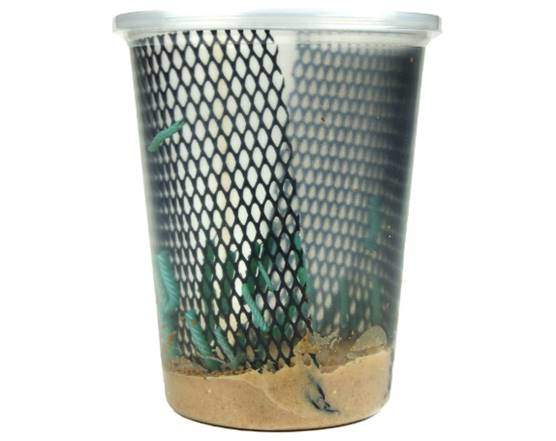
6. Mealworms
Mealworms are Tenebrio molitor beetle larvae, one of the most popular animal feeder insects ideals for insectivorous reptiles, amphibians, small mammals, birds, fish, and poultry or as fishing baits.
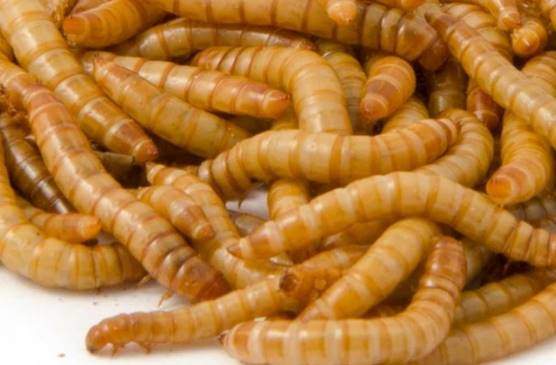
Your bearded dragons can eat mealworms, including their pupas and adult beetles as an occasional food or a small part of their diet. They are suitable for these pets but not as a staple feeder insect.
Looking at their nutritional analysis, they have 62.44% moisture, 12.72% fats, 20.27% proteins, 1.73% fiber, and 1.57% ash, making them relatively nutritious.
However, their calcium is low (133ppm), and phosphorus is more 335ppm, meaning they have low calcium to phosphorus ratio of about 1:2.5.
Benefits
- Cheap to buy. You can get both live mealworms and dried mealworms at local pet stores or online at affordable prices.
- They have a longer shelf-life in refrigerated at 45-50 degrees Fahrenheit as they go dormant.
- They are available in various sizes, i.e., they come ½”, ¾” or 1″ making it easy to pick a correct size for your pet.
- They are easier to feed when compared to crickets or grasshoppers as they do not leap. You can quickly raise mealworms at home even for profit.
- They don’t smell, don’t make any noise, have a high efficiency of converting food to bugs, need a small space, and so on.
On how many, give your adult bearded dragon 5-6 mealworms in a day, two to three times in a week. They are high in fats and not as nutritious as staple feeder insects. Excessive amounts may cause obesity and hepatic lipidosis.
Juvenile beardies can also eat a few mealworms once they are at least six months. However, baby bearded dragons should not eat mealworms as they have a tough exoskeleton (chitin) that may be hard to digest or cause impaction.
7. Superworms (King Worms, Morio Worms or Zophobas)
Superworms are larvae of Zophobas morio, a darkling beetle species. Their size is 1.7–2.25 inches. Many people confuse them with giant mealworms. However, they are darker or black towards the ends of their body.
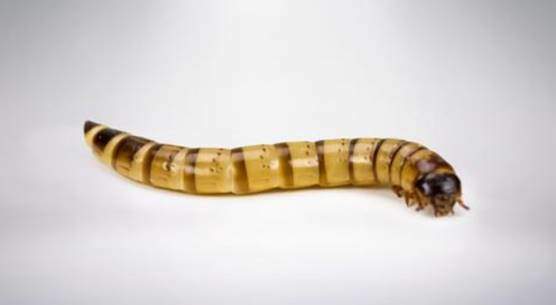
These kingworms are popular feeder insects to lizards, frogs, salamanders, turtle, koi, birds, poultry, and other animals that feed on insects.
Key facts
- Nutritionally, they are comparable to mealworms. However, they have a harder exoskeleton (more chitin), making them harder to digest.
- Unlike adult Zophobas morio beetle that has a defensive odor, these worms are odorless.
- Unlike giant mealworms that have hormones to prevent pupation, morio worms don’t. Therefore, to prevent pupation, keep them together. So long as they touch each other, they will not pupate.
- Refrigeration kills superworms, and they can bite or sting (their jaws are stronger and have spikes on their head for defense). Crush their head to stop this or remove any uneaten.
- They are voracious eaters who turn to cannibalism if they are overcrowded. They mainly eat pupas.
Nutritional analysis: Moisture 61.92%, Fat 14.19%, Protein 19.06%, Fiber 2.6%,Calcium 173 ppm.
Can bearded dragons eat superworms? Yes, beardies can eat superworms but not as a staple feeder insect. They are suitable for adult bearded dragons over 16 inches in size.
For juveniles, give them those that are smaller in size and check for any signs of an impaction as well as their poop to see if they digest them well. However, do not feed them to your baby beardie as they are big and have a hard exoskeleton.
On amounts, depending on their size, give your bearded dragon about 5-10 superworms in a day, only a few times a week or occasionally. Instead, feed these pets staple feeder insects such as crickets, Dubia roaches, silkworms, and so on often.
Raising superworms is not bad, so long as you provide them with enough food and don’t overcrowd them. However, you can also buy live superworms online or go for the dried superworms if you want something that will last longer.
8. Butterworms
Butterworms (trevo worms or tebo worms) are the larval stage of the invasive Chilean moth (Chilecomadia moorei) used as fishing baits and feeder insects to insectivorous pets including geckos, bearded dragons, aquatic turtles, monitors, chameleons, fat tail geckos, centipedes, scorpions, tarantulas, among others.
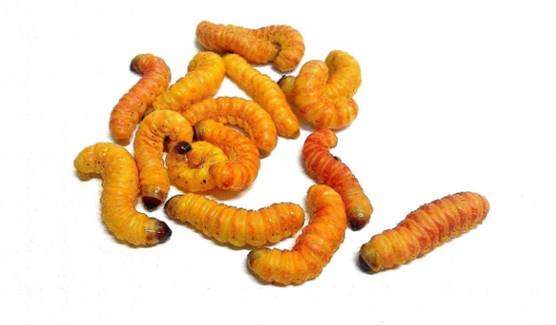
They are better than mealworms and waxworms nutritionally. Therefore, you can feed them as semi-staple feeder bugs or as a regular snack. They come in sizes ranging from 3/8″ and 1.5″.
Benefit
- They are lower in fats (about 5%) and higher in calcium (about 430ppm) but more moderate in protein (16%).
- Their bright color and scent attract bearded dragons that are stubborn eaters.
- They are easy to store. You need to refrigerate these bugs at 38-50 degrees Fahrenheit, and they will go into hibernation mode.
- Easy to digest, no exoskeleton.
However, they are difficult to breed under captivity. It will be better to buy live butterworms for bearded dragons online or import from Chile. During importation, irradiation helps in killing bacteria they may have and help prevent them from pupating.
9. Waxworms
Waxworms are the larvae stage of wax moths (webworms, bee moth, bee millers, or wax millers) with the Achroia grisella (lesser wax moth) and Galleria mellonella (greater wax moth) the commonly bred species. Waxworms are medium in size and white in color with a small black or brown head, and their feet have black tips.
Can bearded dragon eat wax worms? Are they good or bad? Yes. Beardies can eat wax worms. They are ok for these pets, and others terrarium raised pets like geckos, brown anole, neon tree dragon, chameleons, turtles, assassin bugs or as fishing bait, and so on.
However, since they are very high in fats, give them a small amount as a treat and not staple feeder insects. Feed your bearded dragons 5-6 waxworms in a day, occasionally. Avoid giving them to your baby dragons since they are a little bit fatty unless you want to fatten emaciated beardies.
Besides being higher in fats, they are also higher in phosphorus with a Ca:P ratio of 1:7 and have lesser proteins if you compare them with mealworms, crickets, and roaches.
Benefits
- They are easy to raise under captivity as they can tolerate lower temperatures, they eat very little and can feed on cereals, grans and honey. However, they are sensitive to high humidity and can climb smooth vertical walls.
- You can store them for over a month at 55°-60°F or if you put them on the warm side of your refrigerator, and they will last for a month with very little food. Remove any that turns black.
- They have a soft body and are small in size (can reach about 1” in size), making them easy to digest and suitable for smaller beardies.
- They are higher in calcium but a poor Ca:P ratio.
If you don’t want to raise them at home, you can buy live waxworms online, at pet stores or from local breeders near you.
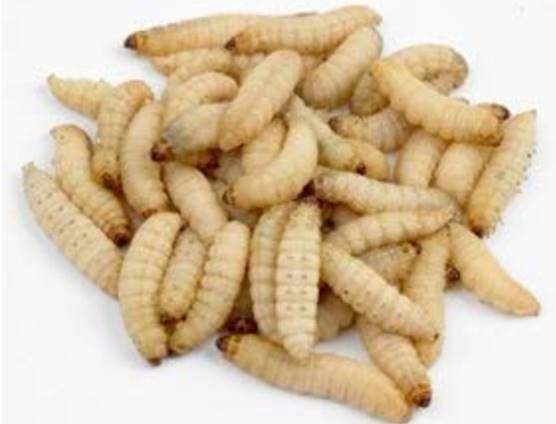
Finally, live waxworms can be fed to small mammals such as hedgehogs, frogs, newts, salamander while roasted or dried wax worms are food to humans
10. Fruit flies
Fruit flies belong to the family Drosophilae. Some species like Drosophila hydei or the giant fruit fly are about 1/8″ in size and Drosophila melanogaster, vinegar flies or common fruit fly are 1/16″ and commonly used as feeder insects especially those that are flightless due to a genetic mutation.
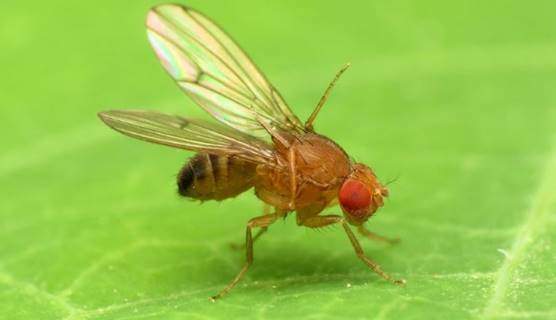
Pets such as praying mantis, anoles, spiders, bettas, poison dart frogs, young frogs, as well as other small reptiles, fish, and amphibians, can eat fruit flies.
Hatchlings, juvenile or small bearded dragons can eat fruit flies, the Drosophila hydei, which is bigger and meatier. Bigger ones may ignore fruit flies as they are too small.
You can buy live wingless or flightless fruit flies in fruit fly media or culture. For instance, Josh’s Frogs has both for wingless Drosophila Melanogaster or flightless Drosophila hydei.
To continue raising them, buy their food such as the Repashy Superspy drosophila culture to maximize their nutritional value as they breed.
Remember to gut-load them, keep them in correct temperatures of 70-75 degrees Fahrenheit for vinegar fly or 78-83 degrees Fahrenheit for the giant fruit fly. Avoid direct sunlight and ensure their culture does not become moldy.
11. Pinky mice and fuzzy mice?
A pinky mouse is a newborn mouse that has not yet grown fur. A smaller pinkie mouse is about a day old and weighs around 1-2g and is approximately 0.5” to 1” while the larger pinky mouse is about 2-5 days old and weighs 2.3-3.5g and may be between 0.5” to 1.25”.
On the other hand, a fuzzy mouse is one that some fur but doesn’t move much, and their eyes are not yet open. A small fuzzy mouse is 6-9 days old, eight 3.5 to 5g, and measures 1” to 1.17” while a larger one is 10-14 days, weighs 5-7.5g, and is about 1” to 1.17”.
Can beardies eat pinky and fuzzy mice? Yes. Bearded dragons can eat pinkie and fuzzy mice. It is excellent as a whole prey. Avoid those that are past fuzzy stages such as juvenile and adult mouse (may bite back and are huge). Furthermore, owning their big size, feed them only to adult bearded dragons or larger juveniles.
There is a debate on whether they can have them occasionally as a treat or regularly with some sources stating that they are high in fats and low in calcium.
On the contrary, looking at their nutritional composition from Redentpros.com, their crude protein (min): 18.25%, crude fat (min): 7.72%, moisture (max): 67.3%ash (max): 3.86%, fat content is not high. These pets can have pinky mice regularly if their raising follows acceptable husbandry guidelines.
Other benefits
- They are soft making them unlikely to cause impaction
- Rich in calcium (the white patch on their belly is their mother’s milk that is rich in calcium)
You can buy either live pinky mice or frozen ones. If they are frozen, keep them at room temperature to defreeze and wait until they have thawed. Do not microwave them.
Finally, you can raise mice for pinky mice since buying them is quite expensive when compared to other live pet feeders.
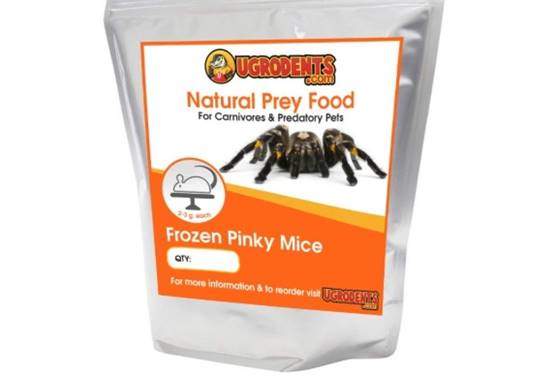
12. Can bearded dragons eat earthworms
Earthworms are segmented worms found in the soil. They belong to the phylum Annelida, live in the ground, and feed dead or live organic matter.

Are earthworms good for a bearded dragon? Can these pets eat them? Yes. Bearded dragons can eat these worms as an occasional treat. They are a good source of moisture (83%), and calcium (444ppm) and some protein (10.5%). However, they are not a popular feeder for these reptiles.
Only buy them from pet stores, reputed online vendors, or bait stores and avoid those that have dyes if you buy them from pet stores. Also, rinse them off before feeding them to your beardies.
13. Grasshoppers
Grasshoppers refer to several insects that belong to the suborder Caelifera that dwell on the ground with strong hind legs. They are one of the insects that most some reptiles eat while in the wild and considered pests, especially in swarms. They are also edible by human beings.
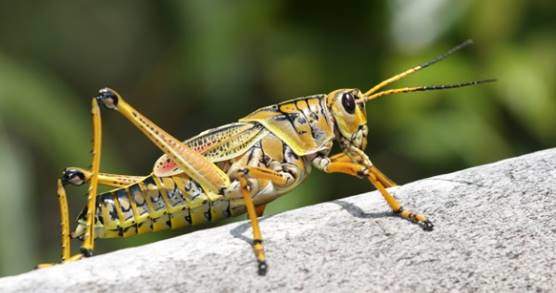
Bearded dragons can eat grasshoppers as one of the staple feeder insects. Grasshoppers, beetles, termites, cockroaches, locusts, ants, and weevils are some of the insects that these lizards eat in the wild.
They are high in proteins as well as essential amino acids and low in fats, making them a great choice to diversify their diet. However, do not feed them wild-caught grasshoppers as they may have parasites or insecticides.
Since they are not readily available and buying them can be quite expensive. Instead, you should consider raising grasshopper as these insects are easy to keep and feed.
Alternatively, you can go for dried grasshoppers such as the Fluker’s Freeze-Dried Grasshoppers and give them 2-3 grasshoppers together with other feeder bugs or insects.
14. Locusts
Locusts refer to several species of short-horned grasshoppers widely considered as pests. Like grasshoppers, bearded dragons can eat grasshoppers but not those caught in the wild. They are high in proteins and low in fats, making them staple feeder insects.

Depending on their size and the size of a beardie, 2-3 grasshoppers are enough per day together with other foods.
Since they are agricultural pests, you cannot ship locusts in the US. However, in other countries, they are available. They are also easy to raise and maintain. However, ensure they don’t escape.
15. Tomato hornworms
Commonly confused with hornworms (Manduca sexta), tomato hornworms (Manduca quinquemaculata) or five-spotted hawkmoth is a different moth species. Although they resemble each other, tomato worms have a black horn on their tail, and their backs have V-shaped markings.
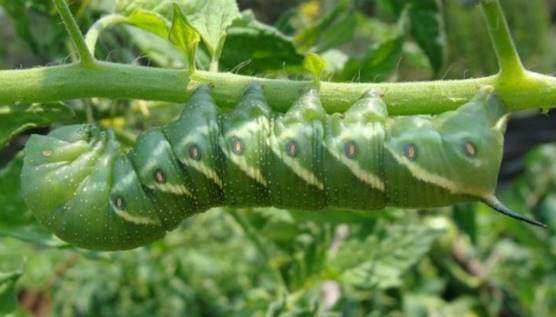
Bearded dragons can eat tomato hornworms. Like hornworms, they are a great feeder, and one tomato worm has a mass equivalent to about 20 medium size crickets.
Besides tomato hornworms being you can rais, they are enticing to these pets (have bright green color), have soft bodies, and many calories.
However, only feed them commercial cultures as tomato and other garden leaves they eat may be having pesticides. Furthermore, tomato leaves may be toxic to your bearded dragons even if you don’t use pesticides.
Do not give these pets any tomato hornworms you pick from your garden or wild as they may have parasites and pesticides, and the food they have eaten may be poisonous.
16. Nightcrawler
Nightcrawlers or dew worms (Lumbricus terrestris) are giant worms that can grow up to 25cm in length. Snakes, toads, fish, frogs, insects, toads, moles, mice, birds, raccoons and other any other animal that eats worms can eat them.
Like earthworms, these bearded dragons can eat nightcrawlers, especially when they are still young. However, go for those purchased online or from a bait or pet store only (farm-grown) and avoid wild-caught ones.
Finally, cut them into smaller pieces to make eating much more manageable and give them sparingly as an occasional treat.
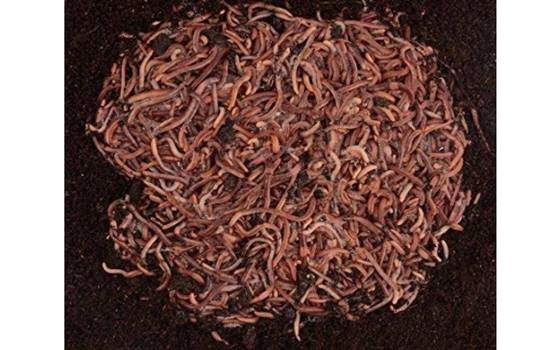
17. Redworms – red wriggler
Eisenia foetida, also known as redworm, red wiggler worm, branding, panfish, trout, or tiger worm is an earthworm species that thrive in decaying organic matter (compost, vegetable, and manure.
Bearded dragons can eat redworms. They are nutritious with a decent amount of protein, and they may help an ailing beardie. However, since they are very long, cutting them into smaller pieces will make eating much more comfortable.
If you need them, buy those free of mites and other harmful insects, especially from reputed breeders or vendors online.
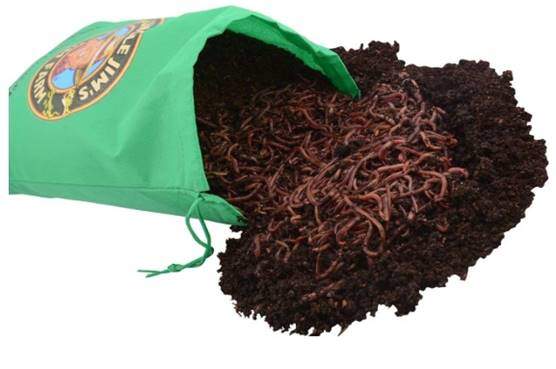
18. Vita bugs
Vita-bugs are nothing other than cricket, mealworm, superworms, hornworm, waxworms, calci-worms, bait worms, and flightless fruit flies fed on modified diets to make them more nutritious and not the rapid-raised ones fed on low-cost foods.
The Vita-bugs’ scientific formulation ensures these bugs are nutrient-rich and hence closely mimic the nutrients that these bugs have while in the wild. For instance, their manufacturer fortifies them with omega-6 and omega-3 fatty acids, beta-carotene, and vitamin E.
19. Blue worms for breaded dragon
Blue worms (Malaysian or Indian Blue worms) are popular worms that many vermicomposters use in tropical regions, including Asia and Australia. We don’t have enough information regarding their use as feeder insects for beardies.
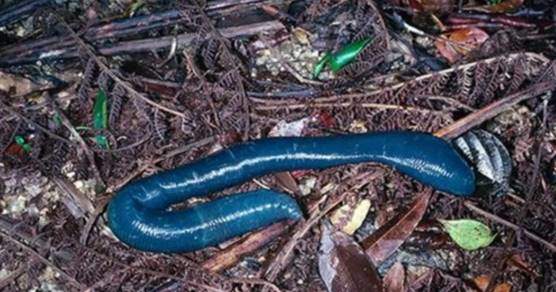
Insects, bugs and things not to feed bearded dragons
Some of the harmful, dangerous or toxic insects you should not feed your bearded dragons include:
- Ants
- Stinging insects like bees, wasps, and hornets
- Some caterpillars, such as the monarch butterfly caterpillar, especially if they eat swan plants.
- Centipedes and millipedes
- Fireflies
- Lubber grasshoppers
- Scorpions
- Houseflies
Avoid any wild caught insects or grubs, as they may have pesticide residue and parasites. Similarly, wild-caught geckos and anoles or other lizards may have internal parasites.
Also, avoid meat pieces such as liver, gizzard, chicken, turkey, beef hearts, and so on as they run a risk of being deficient in minerals and vitamins. Give them whole food.
Finally, do not give your pets live fish as it often loaded with parasites and will deplete niacin form your beardies body.
